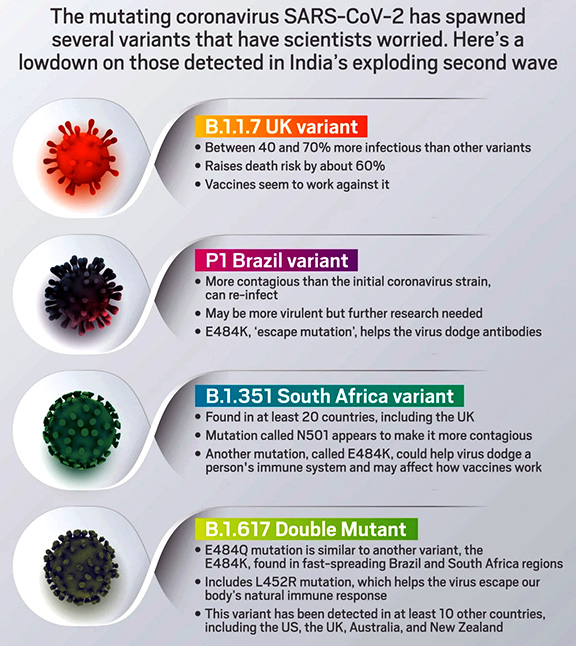Nomenclature & Classification of Corona Variants | 03 May 2021
Why in News
Recently, India’s Health Ministry said that a new double mutant variant of the coronavirus had been detected in addition to many other strains or Variants of Concern (VOCs) found in 18 states in the country.
Key Points
- Virus Variant:
- Variants of a virus have one or more mutations that differentiate it from the other variants that are in circulation. While most mutations are deleterious for the virus, some make it easier for the virus to survive.
- The SARS-CoV-2 (Corona) virus is evolving fast because of the scale at which it has infected people around the world. High levels of circulation mean it is easier for the virus to change as it is able to replicate faster.
- The original pandemic virus (founder variant) was Wu.Hu.1 (Wuhan virus). In a few months, variant D614G emerged and became globally dominant.
- Classification:
- The US Centers for Disease Control and Prevention (CDC) classifies variants into three categories:
- Variant of Interest (VOI):
- A variant with specific genetic markers that have been associated with changes to receptor binding, reduced neutralization by antibodies generated against previous infection or vaccination, reduced efficacy of treatments, potential diagnostic impact, or predicted increase in transmissibility or disease severity.
- An example of VOI is the B.1.617 variant of the virus which has two mutations, referred to as E484Q and L452R.
- This variant is classified as a VOI by the World Health Organization (WHO) as well.
- Both are separately found in many other coronavirus variants, but they have been reported together for the first time in India.
- Variant of Concern (VOC):
- A variant for which there is evidence of an increase in transmissibility, more severe disease (e.g., increased hospitalizations or deaths), significant reduction in neutralization by antibodies generated during previous infection or vaccination, reduced effectiveness of treatments or vaccines, or diagnostic detection failures.
- The B.1.1.7 (UK variant), B.1.351 (South Africa Variant), P.1 (Brazil Variant), B.1.427, and B.1.429 variants circulating in the US are classified as VOCs.
- Variant of High Consequence:
- A variant of high consequence has clear evidence that prevention measures or medical countermeasures have significantly reduced effectiveness relative to previously circulating variants.
- So far, the CDC has not found variants of high consequence in circulation in the US.
- Variant of Interest (VOI):
- Variants Under Investigation (VUI):
- Public Health England (PHE) says that if the variants of SARS-CoV-2 are considered to have epidemiological, immunological or pathogenic properties, they are raised for formal investigation.
- At this point, the variants emerging from the B.1.617 lineage are designated as VUI.
- The US Centers for Disease Control and Prevention (CDC) classifies variants into three categories:
- Nomenclature:
- Phylogenetic Assignment of Global Outbreak Lineages (PANGOLIN):
- It was developed to implement the dynamic nomenclature of SARS-CoV-2 lineages, known as the Pango nomenclature.
- It uses a hierarchical system based on genetic relatedness – an invaluable tool for genomic surveillance.
- It uses alphabets (A, B, C, P) and numerals starting with 1. Variant lineages are at the emerging edge of the pandemic in different geographies. Lineage B is the most prolific.
- Phylogenetic Assignment of Global Outbreak Lineages (PANGOLIN):
- Concerns Related to Different Variants:
- Increased Transmission:
- In many countries, including India, variants, by virtue of increased transmissibility, have kicked off new wave(s) of epidemic transmission.
- Increased Severity:
- Regarding virulence (propensity to cause severe/life-threatening disease), the UK variant is worse. The South Africa and Brazil variants do not seem to have higher virulence.
- Lowered Immunity:
- The third concern is regarding the immunity cover offered by vaccination using antigens made from D614G variant — which applies to most vaccines in current use.
- Lowered efficacy of vaccines was found more with the South African and less with the Brazil variant. Hence, reinfection can occur in spite of immunity by earlier D614G infection or vaccination.
- Vaccine efficacy may be lower now than what was determined in phase-3 trials as VOC were not then widely prevalent.
- Fortunately, mRNA vaccines have broader immunity for different reasons, and they protect better against these two variants.
- Increased Transmission:
- Possible Solution:
- Karolinska Institute in Sweden has created an antigen using new variant RBD (Receptor Binding Domain) peptide with adjuvant, and inoculated monkeys already primed with an older vaccine.
- A RBD is a short immunogenic fragment from a virus that binds to a specific endogenous receptor sequence to gain entry into host cells.
- An adjuvant is a substance that enhances the immune system's response to the presence of an antigen.
- The resultant booster response was not only high but also broad, covering new variants. This approach, called ‘hetero boosting’ by a different vaccine, offers a way to manage the ‘vaccine-escape’ variants until newer vaccines become available.
- Karolinska Institute in Sweden has created an antigen using new variant RBD (Receptor Binding Domain) peptide with adjuvant, and inoculated monkeys already primed with an older vaccine.
Way Forward
- The pandemic has shown the critical importance of biomedical research and capacity building – for saving lives and economic growth.
- We need a foundation of broad-based research, in universities, medical colleges and biotechnology companies, all of which must be funded, encouraged, appreciated, and talent rewarded.
- While some endeavours have been initiated, they must take off in a big way, and India must invest heavily in biosciences. After a decade, its products and profit will make us healthier and wealthier.

